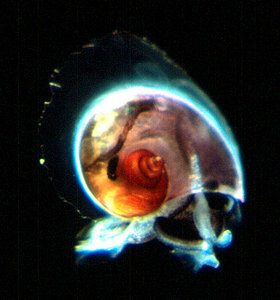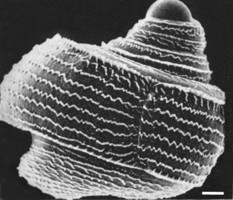Atlanta brunnea
Atlanta fusca
Roger R. SeapyIntroduction
Atlanta brunnea is a small species (shell diameter to 2.0 mm) with a light to dark brown, amber, or reddish-brown body and a light black mantle. The keel is tall and inserts between the last and penultimate shell whorls in animals larger than 1.5 mm. The spire is tall and conical, consisting of 4 whorls and possessing a complex pattern of spiral sculpture that is replaced on the adult shell whorl by spiral rows of small tubercles, or punctae. Eyes type a, operculum type a, and radula type I. Geographic distribution of A. brunnea is cosmopolitan in tropical to subtropical waters, where it is consistently rare. In a study of diel vertical distribution in Hawaiian waters, it was found to be limited to the upper 90 m during the day, with some evidence of vertical migration into the upper 45 m at night.
Diagnosis
- Maximal shell diameter = 2.0 mm
- Keel tall and inserts between last and penultimate whorls in shells >1.5 mm diameter
- Spire tall and conical, with ornate and complex sculpture; replaced by spiral rows of small tubercles on adult shell whorls
- Body light to dark brown, amber, and reddish-brown; mantle light black
- Eyes type a; operculum type a; radula type I
Characteristics
- Shell
- Small, with maximal shell diameter = 2.0 mm
- Keel tall and rounded (see first SEM below)
- Keel inserts between the last and penultimate shell whorls in shells larger than 1.5 mm (see first SEM below)
-
Spire (protoconch) of four whorls, with ornate and complex surface sculpture. A prominent spiral ridge is located on the outer margin of each spire whorl beginning on the second whorl and progressing in height through the fourth whorl (see the two SEMs below)
-
Spire sculpture replaced on adult portion of shell (teleoconch) by spiral rows of small tubercles, or punctae (click on second image below)
- Body coloration light to dark brown, amber, or reddish-brown (see title illustrations and photograph below); mantle light black (see second title illustration)
- Eyes type a; lacking a transverse slit in the distal pigmented tissue
- Operculum type a (macro-oligogyre)
- Radula type I, small and ribbon shaped. Like Atlanta turriculata, each tooth row includes a monocuspid central, rachidian tooth, with a postero-lateral process on each side, and (on either side of the central tooth) a biscuspid lateral tooth, with a strong rectangular process on the inner side, and a pair of monocuspid marginal teeth
- Larva
- The two lobes of the velum seen in early larvae give rise to six-lobes with larval growth
 Click on an image to view larger version & data in a new window
Click on an image to view larger version & data in a new window
Figure. Early (left) and late (right) stage larvae of Atlanta brunnea. Drawings from Franc (1948, Figs. 10, 11). © 1948 A. Franc

Figure. Late veliger larva of Atlanta brunnea with six, ciliated velar lobes. Scale bar = 0.5 mm. Modified from Richter (1968, Fig. 11). © 1968 G. Richter
- Surface sculpture of larval shell (excepting the apical portion, protoconch I) of multiple, parallel spiral ridges
 Click on an image to view larger version & data in a new window
Click on an image to view larger version & data in a new windowFigure. Larval shell of Atlanta brunnea. Left: Scanning electron micrograph of shell viewed in the shell plane. Scale bar = 50 µm. Modified from Thiriot-Quiévreux (1973, Fig. 6b). © 1973 C. Thiriot Right: Sketches of three stages in the development of the larval shell. Scale bar = 250 µm. Modified from Richter (1968, Fig. 10). © 1968 G. Richter
- The two lobes of the velum seen in early larvae give rise to six-lobes with larval growth
Comments:
Atlanta brunnea is a cosmopolitan species, found at tropical to subtropical latitudes. From quantitative studies of the atlantid faunas in the northeastern Indian Ocean (Richter, 1974) and the North Pacific off Hawaii (Seapy, 1990a,b and 2008), one would conclude that A. brunnea is a rare species. In Richter's study it represented only 0.3% of the total numbers. Based on species counts from five sampling periods off leeward Oahu, Hawaii (Seapy, 1990a) it ranked tenth of thirteen atlantids (0.8% of total numbers). And, in a subsequent study (Seapy, 2008) it ranked twelfth of fourteen species (tied with A. echinogyra), representing 0.1% of the total mean nighttime abundances.
Diel patterns of vertical distribution in A. brunnea were studied off leeward Oahu by Seapy (1990b), and indicated that it is a shallow-dwelling species. It was recorded in the upper 90 m of the water column during both day and night periods, but showed only limited evidence of nocturnal migration; from 45-90 m during the day into the upper 45 m at night, where the abundance averaged 1.3 individuals per 1,000 m3.
References
Franc, A. 1948. Véligères et mollusques gastéropodes des Baies d'Alger et de Banyuls. Journal de Conchyliologie (Paris) 88: 3-35, 2 plates.
Richter, G. 1968. Heteropoden und Heteropodenlarven im Oberflächenplankton des Golfs von Neapel. Pubblicazioni della Stazione Zoologica di Napoli 36: 346-400.
Richter, G. 1974. Die Heteropoden der "Meteor" Expedition in den Indischen Ozean 1964/65. "Meteor" Forschungs-Ergibnisse Ser. D, No. 17, pp. 55-78.
Richter, G. and R. R. Seapy. 1999. Heteropoda, pp. 621-647. In: D. Boltovskoy (ed.), South Atlantic Zooplankton. Backhuys Publishers, Leiden.
Seapy, R. R. 1990a. The pelagic family Atlantidae (Gastropoda: Heteropoda) from Hawaiian waters: a taxonomic survey. Malacologia 32: 107-130.
Seapy, R. R. 1990b. Patterns of vertical distribution in epipelagic heteropod molluscs off Hawaii. Marine Ecology Progress Series 60: 235-246.
Seapy, R. R. 2008. Offshore-onshore and vertical distributional patterns of heteropod mollusks off leeward Oahu, Hawaii. Marine Biology 154: 985-995.
Thiriot-Quiévreux, C. 1973. Heteropoda. Oceanography and Marine Biology Annual Review 11: 237-261.
Title Illustrations

| Scientific Name | Atlanta brunnea |
|---|---|
| Location | Hawaiian waters |
| Specimen Condition | Live Specimen |
| Sex | Male |
| Life Cycle Stage | adult |
| View | right side |
| Image Use |
 This media file is licensed under the Creative Commons Attribution-NonCommercial License - Version 3.0. This media file is licensed under the Creative Commons Attribution-NonCommercial License - Version 3.0.
|
| Copyright |
©

|
| Scientific Name | Atlanta brunnea |
|---|---|
| Location | Hawaiian waters |
| Specimen Condition | Live Specimen |
| Sex | Male |
| Life Cycle Stage | adult |
| View | right side, tilted |
| Image Use |
 This media file is licensed under the Creative Commons Attribution-NonCommercial License - Version 3.0. This media file is licensed under the Creative Commons Attribution-NonCommercial License - Version 3.0.
|
| Copyright |
©

|
About This Page

California State University, Fullerton, California, USA
Correspondence regarding this page should be directed to Roger R. Seapy at
Page copyright © 2011
 Page: Tree of Life
Atlanta brunnea . Atlanta fusca .
Authored by
Roger R. Seapy.
The TEXT of this page is licensed under the
Creative Commons Attribution License - Version 3.0. Note that images and other media
featured on this page are each governed by their own license, and they may or may not be available
for reuse. Click on an image or a media link to access the media data window, which provides the
relevant licensing information. For the general terms and conditions of ToL material reuse and
redistribution, please see the Tree of Life Copyright
Policies.
Page: Tree of Life
Atlanta brunnea . Atlanta fusca .
Authored by
Roger R. Seapy.
The TEXT of this page is licensed under the
Creative Commons Attribution License - Version 3.0. Note that images and other media
featured on this page are each governed by their own license, and they may or may not be available
for reuse. Click on an image or a media link to access the media data window, which provides the
relevant licensing information. For the general terms and conditions of ToL material reuse and
redistribution, please see the Tree of Life Copyright
Policies.
- First online 15 December 2008
- Content changed 23 July 2011
Citing this page:
Seapy, Roger R. 2011. Atlanta brunnea . Atlanta fusca . Version 23 July 2011. http://tolweb.org/Atlanta_brunnea/28759/2011.07.23 in The Tree of Life Web Project, http://tolweb.org/


















 Go to quick links
Go to quick search
Go to navigation for this section of the ToL site
Go to detailed links for the ToL site
Go to quick links
Go to quick search
Go to navigation for this section of the ToL site
Go to detailed links for the ToL site